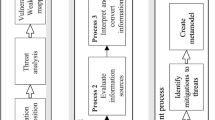Abstract
Designing secure and reliable systems is a difficult task. Threat modeling is a process that supports the secure design of systems by easing the understanding of the system’s complexity, as well as identifying and modeling potential threats. These threat models can serve as input for attack simulations, which are used to analyze the behavior of attackers within the system. To ensure the correct functionality of these attack simulations, automated tests are designed that check if an attacker can reach a certain point in the threat model. Currently, there is no way for developers to estimate the degree to which their tests cover the attack simulations and, thus, they cannot the determine the quality of their tests. To resolve this shortcoming, we analyze structural testing methods from the software engineering domain and transfer them to the threat modeling domain by following an Action Design Research approach. Further, we develop a first prototype, which is able to assess the test coverage in an automated way. This will enable threat modeler to determine the quality of their tests and, simultaneously, increase the quality of the threat models.
Access this chapter
Tax calculation will be finalised at checkout
Purchases are for personal use only
Similar content being viewed by others
Notes
- 1.
We are aware that defenses might be effective by a probability. However, testing non-deterministic behavior is challenging and, thus, we make the assumption that a defense is either effective or not.
- 2.
- 3.
References
Ammann, P., Offutt, J.: Introduction to Software Testing, 2nd edn. Cambridge University Press, New York (2016)
Chi, S.-D., Park, J.S., Jung, K.-C., Lee, J.-S.: Network security modeling and cyber attack simulation methodology. In: Varadharajan, V., Mu, Y. (eds.) ACISP 2001. LNCS, vol. 2119, pp. 320–333. Springer, Heidelberg (2001). https://doi.org/10.1007/3-540-47719-5_26
Cohen, F.: Simulating cyber attacks, defences and consequences. Comput. Secur. 18(6), 479–518 (1999)
Ekstedt, M., Johnson, P., Lagerström, R., Gorton, D., Nydrén, J., Shahzad, K.: SecuriCAD by Foreseeti: a CAD tool for enterprise cyber security management. In: 19th International EDOC Workshop, pp. 152–155. IEEE (2015)
Goodenough, J.B., Gerhart, S.L.: Toward a theory of test data selection. IEEE Trans. Softw. Eng. 2, 156–173 (1975)
Gulati, S., Sharma, R.: JUnit 5 Extension Model, pp. 121–137. Apress, Berkeley (2017)
Hacks, S., Hacks, A., Katsikeas, S., Klaer, B., Lagerström, R.: Creating meta attack language instances using ArchiMate: applied to electric power and energy system cases. In: 23rd International EDOC, pp. 88–97 (2019)
Hacks, S., Katsikeas, S., Ling, E., Lagerström, R., Ekstedt, M.: powerlang: a probabilistic attack simulation language for the power domain. Energy Inform. 3(1), 30 (2020). https://doi.org/10.1186/s42162-020-00134-4
Holm, H., Shahzad, K., Buschle, M., Ekstedt, M.: P\(^2\)CySeMoL: predictive, probabilistic cyber security modeling language. IEEE Trans. Dependable Secure Comput. 12(6), 626–639 (2015)
Johnson, P., Lagerström, R., Ekstedt, M.: A meta language for threat modeling and attack simulations. In: 13th ARES Conference, pp. 1–8 (2018)
Jürjens, J.: UMLsec: extending UML for secure systems development. In: Jézéquel, J.-M., Hussmann, H., Cook, S. (eds.) UML 2002. LNCS, vol. 2460, pp. 412–425. Springer, Heidelberg (2002). https://doi.org/10.1007/3-540-45800-X_32
Katsikeas, S., et al.: An attack simulation language for the IT domain. In: Eades III, H., Gadyatskaya, O. (eds.) GraMSec 2020. LNCS, vol. 12419, pp. 67–86. Springer, Cham (2020). https://doi.org/10.1007/978-3-030-62230-5_4
Katsikeas, S., Johnson, P., Hacks, S., Lagerström, R.: Probabilistic modeling and simulation of vehicular cyber attacks: an application of the meta attack language. In: 5th ICISSP (2019)
Kordy, B., Mauw, S., Radomirović, S., Schweitzer, P.: Foundations of attack–defense trees. In: Degano, P., Etalle, S., Guttman, J. (eds.) FAST 2010. LNCS, vol. 6561, pp. 80–95. Springer, Heidelberg (2011). https://doi.org/10.1007/978-3-642-19751-2_6
Limited, A.T.: Hostile risk decisions and capabilities-based analysis (2020). https://www.amenaza.com/downloads/docs/Hostile
Mauw, S., Oostdijk, M.: Foundations of attack trees. In: Won, D.H., Kim, S. (eds.) ICISC 2005. LNCS, vol. 3935, pp. 186–198. Springer, Heidelberg (2006). https://doi.org/10.1007/11734727_17
Miranda, B., Bertolino, A.: Testing relative to usage scope: Revisiting software coverage criteria. ACM Trans. Softw. Eng. Methodol. 29(3), 1–24 (2020)
Myagmar, S., Lee, A.J., Yurcik, W.: Threat modeling as a basis for security requirements. In: SREIS, vol. 2005, pp. 1–8. Citeseer (2005)
do Nascimento, L.M., Viana, D.L., Neto, P., Martins, D., Garcia, V.C., Meira, S.: A systematic mapping study on domain-specific languages. In: ICSEA 2012, pp. 179–187 (2012)
Offutt, J., Liu, S., Abdurazik, A., Ammann, P.: Generating test data from state-based specifications. Softw. Test. Verif. Reliab. 13(1), 25–53 (2003)
Oladimeji, E.A., Supakkul, S., Chung, L.: Security threat modeling and analysis: a goal-oriented approach. In: SEA 2006, pp. 13–15. Citeseer (2006)
Saini, V., Duan, Q., Paruchuri, V.: Threat modeling using attack trees. J. Comput. Sci. Coll. 23(4), 124–131 (2008)
Schneier, B.: Attack trees. Dr. Dobb’s J. 24(12), 21–29 (1999)
Sein, M.K., Henfridsson, O., Purao, S., Rossi, M., Lindgren, R.: Action design research. MIS Q. 35(1), 37–56 (2011)
Sheyner, O., Haines, J., Jha, S., Lippmann, R., Wing, J.M.: Automated generation and analysis of attack graphs. In: Proceedings 2002 IEEE Symposium on Security and Privacy, pp. 273–284. IEEE (2002)
Shostack, A.: Threat Modeling: Designing for Security. Wiley, Indianapolis (2014)
Tuglular, T., Kaya, Ö., Müftüoglu, C.A., Belli, F.: Directed acyclic graph modeling of security policies for firewall testing. In: International Conference on Secure Software Integration and Reliability Improvement, pp. 393–398. IEEE (2009)
Acknowledgement
This project has received funding from the European Union’s H2020 research and innovation programme under the Grant Agreement No. 832907.
Author information
Authors and Affiliations
Corresponding author
Editor information
Editors and Affiliations
Rights and permissions
Copyright information
© 2021 Springer Nature Switzerland AG
About this paper
Cite this paper
Hersén, N., Hacks, S., Fögen, K. (2021). Towards Measuring Test Coverage of Attack Simulations. In: Augusto, A., Gill, A., Nurcan, S., Reinhartz-Berger, I., Schmidt, R., Zdravkovic, J. (eds) Enterprise, Business-Process and Information Systems Modeling. BPMDS EMMSAD 2021 2021. Lecture Notes in Business Information Processing, vol 421. Springer, Cham. https://doi.org/10.1007/978-3-030-79186-5_20
Download citation
DOI: https://doi.org/10.1007/978-3-030-79186-5_20
Published:
Publisher Name: Springer, Cham
Print ISBN: 978-3-030-79185-8
Online ISBN: 978-3-030-79186-5
eBook Packages: Computer ScienceComputer Science (R0)




